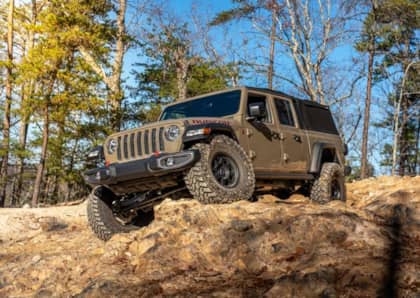The Evolution of Truck Badges
Horsepower, torque, tow ratings and payload capacities aren’t the only things that’ve gone hog wild on American pickups over the past three decades. To accommodate the ever more powerful engines that are required to meet the trucks’ perpetually-increasing capabilities, Ford, GM and Ram have had to upsize or increase the amount of heat exchangers stacked in front of their engines to keep them cool. Then, to ensure these auxiliary coolers see adequate airflow, the grilles in front of them have grown larger and larger—along with the badge in the middle.
So, is the larger identifier on the face of our trucks more of an in-your-face marketing ploy or simply an effort to keep the emblem proportional to grille size? No matter the case, the primary identifier on each of the Big Three’s trucks has evolved in both size and design over the years. Below, we’ll explore the evolution of Ford’s classic blue oval, Chevrolet’s time-tested bowtie and Dodge’s iconic ram logo.
Curious as to the progression of the badging on your favorite make? You can study the evolution of 25 of the biggest automotive manufacturer’s logos here.
Ford’s Original Blue Oval (1927-2002)

The classic Ford logo which first debuted in 1927 can be found on 75 years worth of the automaker’s vehicles. The cursive Ford name is enclosed by a thick white line that’s surrounded by a thin blue border. Above, a version of Ford’s original emblem is fastened to a 1997 model year F-350’s grille. It spans 4.75-inches wide and 2-inches in height—a far cry from the dimensions of the current emblems that are attached to its Super Duty. For comparison’s sake, on a 2015 model year F-350 the tailgate emblem alone measures 9-inches wide by 3.5-inches tall.
2003-Present

From a design standpoint, Ford’s logo was treated to an increase in lighting in 2003. This change contrasted the once dark blue background and, thanks to brightening up the lettering, made the Ford name much more pronounced. As for the real estate the emblem consumed, the upsizing of the blue oval was subtle at first. However, by the 2008 model year Super Duty you couldn’t miss it. Then when Ford’s grille size swelled even more on the 2011 trucks (along with the introduction of drastically thicker center bars), so did the emblem.
Chevrolet’s Golden Bowtie (1982-1994)

The Chevrolet bowtie (or gold cross) has been around since 1913, in one form or another, and you’d be surprised how many variations there are of this iconic symbol. Over the course of the last century, the Detroit-born auto maker has redesigned its logo at least nine different times. The version that was first introduced in 1982 is shown here, aboard a 1984 K5 Blazer.
Subtle Changes in ’95 and Y2K

During the GMT400’s tenure, two notable changes were made. In 1995 the cross shape was treated to some added definition and a slightly darker tone of gold. Then, in an effort to modernize its appearance, the bowtie became three-dimensional for the first time in the year 2000.
The Global Bowtie Badge

In 2004, the thin black outline surrounding the bowtie was phased out and all-gold was phased in. Additionally, the overall size of the emblem was upsized, albeit slightly (for now). This version of the Chevrolet logo is also known as the brand’s first global bowtie badge.
Global Bowtie 2.0

Bigger and bolder. As part of the logo redesign Chevrolet began work on in order to celebrate its 100th anniversary in 2011, this version was given a thicker silver frame while retaining the previous generation’s golden hue on the bowtie itself. In 2013, added texture brought one of the most recognizable brand logos to life even more.
What Happened to the Bowtie?

Not much bowtie evolution going on here… So what happened to the stand-alone gold cross that Chevy relied so heavily on for brand recognition for decades? We’re not sure what happened inside GM headquarters on this one, but it’s been blamed on everything from focus groups to the pressure for designers to somehow reinvent the wheel. However, all is not lost for traditionalists. You can still have a bowtie out front if you order your Silverado in High Country trim.
Dodge With A Ram (’94-‘02)

Dodge’s ram emblem wasn’t exactly new when it showed up on ’94 model trucks. In fact, the manufacturer had already begun reintroducing it on its cars in 1993—not to mention the fact that ram hood ornaments were used back in the 1930s and even class 8 trucks in the 70s. Located at the center and top of the grille on all second-gen Rams, red Dodge lettering (in all caps) sat above a chiseled rendition of a ram’s head.
Fourth-Gen Logo (’10-‘19)

During the grille change that occurred amid the ’02-’03 Ram body style redesign, the red-lettered Dodge name was removed from the logo but the size and location remained roughly the same through 2009. However, when the fourth-gen Rams debuted for 2010, a larger ram logo was present, and it’d been perfectly centered in the new (larger) grille. Things would remain this way until the next major overhaul of the Ram truck line took place.
RAM, And The Departure Of The Spirit Animal

On the latest generation of Ram trucks (i.e. fifth-gens), the ram emblem’s design didn’t exactly evolve. Rather, the mountain-dwelling, bighorn ram’s head was ditched altogether in a move that mirrors what Chevrolet has done with its Silverado. Love it or hate it, all signs point to a brand name being spelled out in all capital letters going forward. So now with Ram, Chevrolet and obviously GMC on board with this kind of logo design, what do you think they’re thinking over at the Ford camp?
More From Driving Line
- Ready to read up on the engine that saved Dodge trucks? Everything you need to know about the legendary 5.9L Cummins starts right here.











